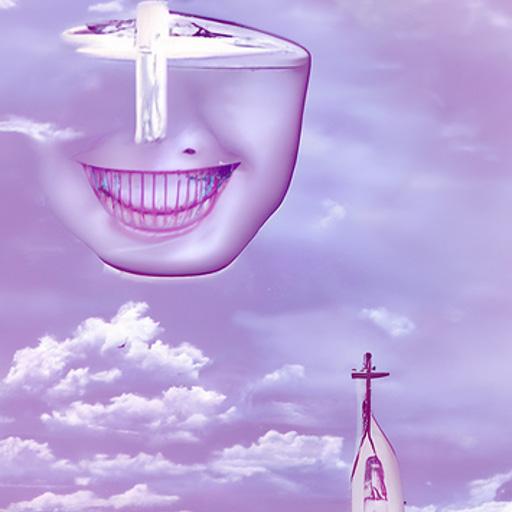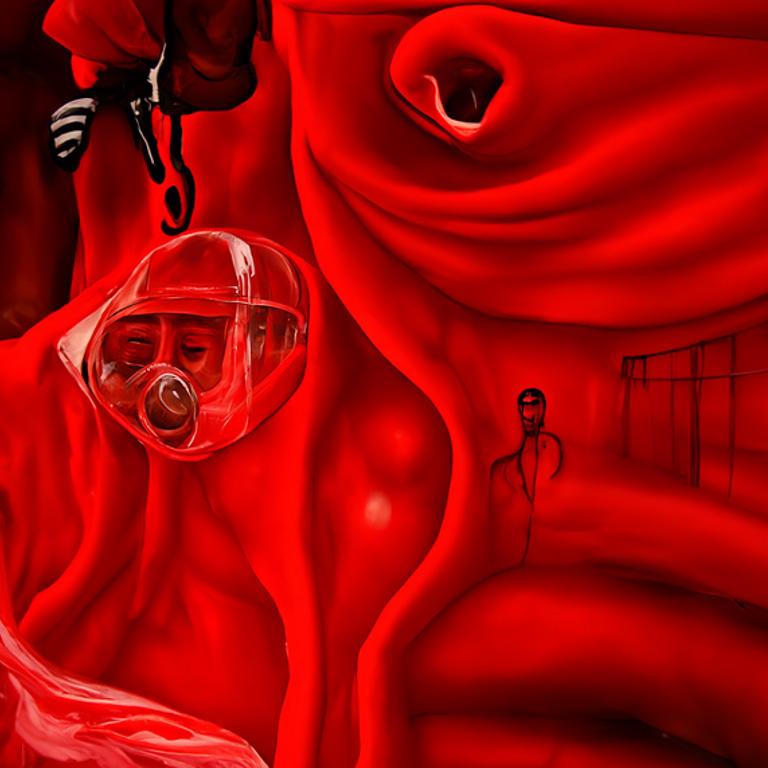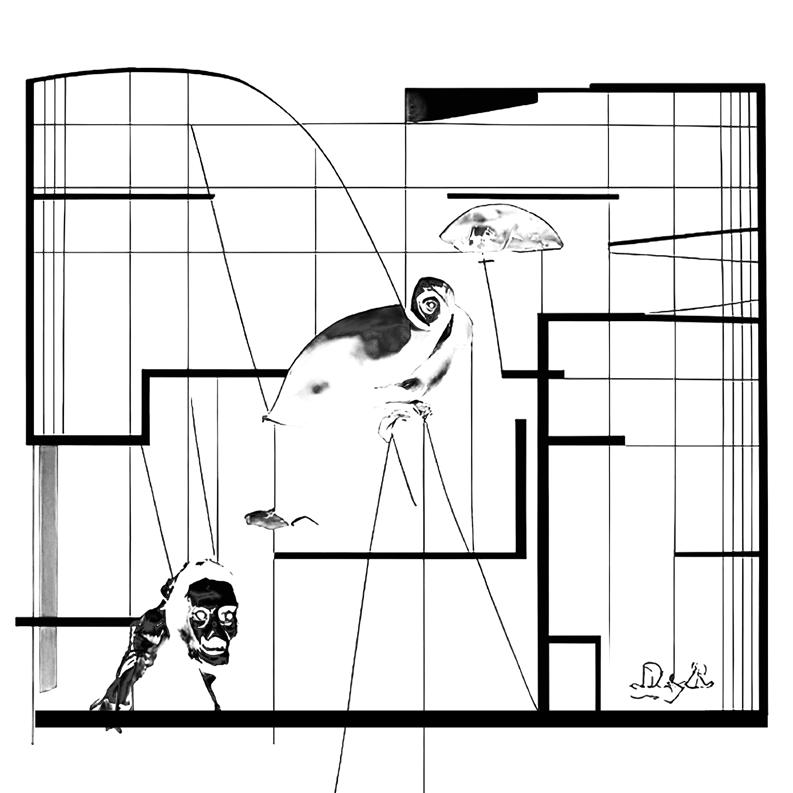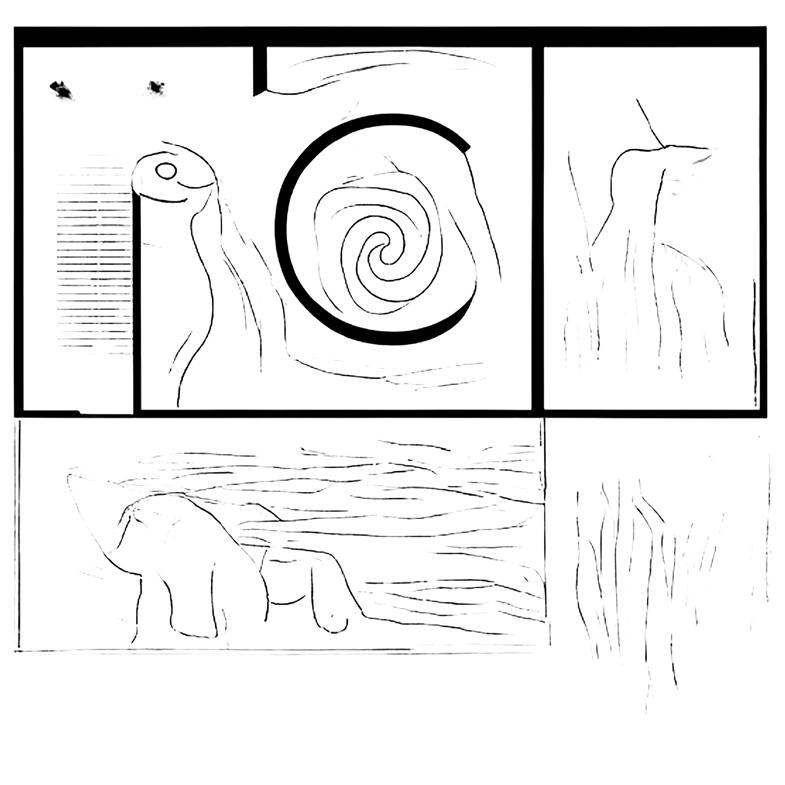
Peter Sloterdijk considers the world as a foamy space filled with bubbles and orbs of different scales and qualities in his trilogy Spheres. The bubble is not purely a metaphor. According to Sloterdijk and his metaphor of the womb, it is an imaginative constitution of our very existence. In a relationship between a person and a building, one unconsciously tries to recreate the relationship between a fetus and its first place to exist - the womb to protect itself from the 'outside'.

In an era of globalisation, these spheres mentioned by Peter Sloterdijk, construct our everyday life with a fluid reality. Architects, often without knowing, not only materialise this public sphere but modify it even just a little. When we architects are making our design, we are dealing with the dreams of people who will live and experience these buildings. These spheres generated by people and architecture propels me to ask and study about the relationship between architectural ideologies and our life.
The sphere can be decisive, it presents the very superficial desire of us. We might get lost when we are busy with satisfying this desire of people. Here, architects have a similar job with philosophers, before solving any problem, it is more important to redefine the problem itself.
The project is an architectural design experiment, that aims to explore and develop the potentiality of a museum space, for it to adapt to the usage of Blind and Low Vision community visiting the museum exhibition. The musical and its stage has incorporated the tradition curation of historical artefacts with tactility and sound. The design book documents the research, the concepts, the production and the design of an architectural space within the Chau Chak Wing Museum — which we imagine to transform to the stage for the musical.

Behind the Scene: Scenic Art (Interactive):


Behind the Scene: Scenic Art Interactive ) :
The Tactile models are to be installed in the theatre space, that aids the BLV audiences in reading the introductory storyline, as well as in establishing an understanding of the theatre space itself.



































Interactive Object Design
Space Tactile Map of the Humpback Whale Migration

Tactile Map of the Humpback Whale Migration


Space Tactile Map of the Trading Route of Ancient Roman Empire Tactile Map of the Trading Route of Ancient Roman Empire
North North Ocean Rome
Continent
Continent
North North Ocean Rome
Ocean Continent feeding
Rome
Rome
Feeding
Breeding
Breeding
Ocean Continent feeding Feeding Breeding

Breeding
Whale route
Whale Route
Whale route
Whale Route
- The sound resembles the songs sang by whales to communicate long distance under water.
- This sound resembles the pipe music used for military order giving in Ancient Rome.
- This dialogue gradually blurs the definition of which language is used by the humans and which one is used by the whales.
- The audience can whisper into the heads, leaving their stories inside this matrix of fragments.

- The other audiences will thus answer to the second head about their own stories, in their languages and their time frame. Then the conversation continues on and on, with the whispers eroding away and entangling to become new language that echoes and echoes in the museum space.
- Striking on the shorter chords, the audience will hear clicks and pulsed calls that are similar to a whale’s sound.
- The audience could strike on the longer chords to hear the Roman songs.
- The continents on the map are plated with plaster to highlight the difference between land and ocean.

- One would follow the 3D printed routes and press the buttons at each habitat interval to hear the whales’ stories.


- One could also press the Roman coin to hear an extended description of Roman history, about their invasion of neighbours, also their communication of culture and economy with other countries.
Symphony of Roman and whale
The second model is composed for a symphony that the Romans and the whale sing together. It takes inspiration from a pan flute, that one could blow into the pipes and the pipes with varied lengths will sound in varied tunes.


Whispering Heads Echoes of stories
The forth model is a recording device embedded in a Roman head sculpture replica that is able to capture one’s whispers and replay it to the other Roman head and also other audiences.












Instrumental Device Ensemble of whales and Romans
The third model is a musical device whose sound reminds one of the clicking 52Hz rhythms of whales and also the lyre harp of Ancient Rome.
alT oge T her super s udio 2022 nsW Winner
Project by Kangcheng Zheng & Hongyu Huang
At our site, George St. in Sydney, feeding nurtures mynas, whose existence threatens native species.
Also, in between the light rail stops, small businesses are struggling, as attention has been drawn to the light rail.

We consider diversity as a positive solution – every one of us belongs here.
To realize this, cycles are altered in our design. Foods can be recycled in the installation: It would go through a mill for shredding, and an Archimedes screw for delivery upwards, where the food would be composted. The installation has a native rain garden, providing habitat for local species and filtering the rainwater.

This progressive program starts with a single object, where people can nurture native floras while reducing the feeding for urban birds. Awareness of protecting native species would rise.

Multiple installations would link reserves nearby, reintroducing local species. Local businesses could join this process, providing services to make spinning a rewarding and adventurous experience.
The final step would connect the installations via a cable system. This system would take the bags only, which is energy efficient, with the help of shopping bags’ gravitational potential.

People of similar interests can join together around the business they want, forming communities.






It is not about building something brand new, but about adapting. It imagines a combination between the efficient urban hydroponic farming and the existing multistory car park building in Singapore’s residential HDB blocks through a modest reconstruction that however achieve a lot into a complex which also includes on the roof top of it. The second flexible community centre and the third, remaining car parking area.
With background research, three factors are fundamental to this adaption. The first is about food security. Because of the ‘30 by 30’ plan, Singapore government is eager to exploit more chance of urban farming in city.

The second is the car lite plan of Singapore. Car ownership will reduce a lot, ideally. This will make us rethink how can we adapt the infrastructure for cars into other function in future.

And another one is the inevitable problem of hotter Singapore. What can architects do more about this type of adaption and what potentials can be realized through architectural way.

Stomata acts as a portal between inside and outside Absorbing CO2, releasing O2 and H2O, as well as transpiration effect. The design of pods is an analogy of the stomata. It penetrates the building and re-connects the relationship between inside and outside. On the other hand, in the scale of a city, the green buildings can be perceived as the stomata of the city fabric.

Project by Kangcheng Zheng & Mia Chen

































as it goes: Art critic announced that art wend through metal, fire and bubble.


Artists sought hard romance in objects.
Gleeful audience settled as a Catholic school girl. Let there be struggle into the limelight.


“short-circuit”
Mementos: Related Images stored on the Internet
Disco Diffusion AI

A similar process of “The Paranoid Critical Method” to process the materials
Dislocation
Juxtaposition
Transformation
Image
Viewer
“Paranoiac-critical activity organizes and objectivizes in an exclusivist manner the limitless and unknown possibilities of the systematic association of subjective and objective ‘significance’ in the irrational ...it makes the world of delirium pass onto the plane of reality.”
Do AI dream of electric sheep?
Do AI dream of electric sheep?
The short answer is yes. AIs have learnt to with our mementoes, with our most obscene desires. Like Dadaism and Surrealism, the result of the Convolutional Neural Network often presents us with an uncanny scene of dislocation, juxtaposition, and transformation of symbolic images. By short-circuiting the AI, we can use the AI to embody architectural design with a higher degree of spontaneity and automatism to paranoically re-imagine an art space of torture and terror. As a result, the architecture of surrealist objects is a mediator to psychoanalyse and decipher our collective dream.
On the other hand, Lacanian psychologists develop psychoanalysis so that humans can better understand the dream and unconscious mind. What if we can do a psychoanalysis session with the dreaming AI? When an Algorithm is producing images after deep learning, in a way, it can be more paranoic than most of us. By intentionally short-circuiting this AI, we can use the AI as the collage, dreaming apparatus to serve as a mediator to describe our dream for us. Unlike a common AI illustrator, the program does not aim to create images that “make sense” but for the sake of paranoically exploring our collective dreams stored on the internet.

When AI is fed with fragmented poems, it will follow the order to produce irrational images based on photorealism. Just like a Surrealist artist, it aims to produce its precise art as mechanically as possible, representing a subconscious vision of the collective mind.





Dadaist poems are like somniloquies – ridiculous, fragmented and meaningless. However, it sometimes shows a rhythm of metaphor, symbolisation and prophecy. As the miserable fate of Cassandra8 people will never take these somniloquies seriously. By inputting Dadaist poems, AI can be short-circuited to generate images that may potentially indicate how we perceive these somniloquies. The AI structure functions like a virtual museum without form.

Surrealist artists like Salvador Dalí, and Andre Breton used automatic techniques to embody art with a higher degree of spontaneity and automatism so they can play with this unconsciousness of humans. Dalí created the methodology - the Paranoid Critical Method to help him perceive reality based on a “delirium of interpretation”. As Dalí writes in Conquest of the Irrational, “Paranoiac-critical activity organizes and objectives in an exclusivist manner the limitless and unknown possibilities of the systematic association of subjective and objective ‘significance’ in the irrational ...it makes the world of delirium pass onto the plane of reality.” 9
















 Cassandra or Kassandra, a Trojan priestess dedicated to the god Apollo and fated by him to utter true prophecies but never to be believed in Greek mythology.
Cassandra or Kassandra, a Trojan priestess dedicated to the god Apollo and fated by him to utter true prophecies but never to be believed in Greek mythology.
Peter Sloterdijk considers the world as a foamy space filled with bubbles and orbs of different scales and qualities in his trilogy Spheres.10 The bubble is not purely a metaphor. According to Sloterdijk and his metaphor of the womb, it is an imaginative constitution of our very existence. In a relationship between a person and a building (or any man-made object), one unconsciously tries to recreate the relationship between a fetus and its first place to exist - the womb to protect itself from the ‘outside’. In order to achieve this purpose, a sphere often functions as an apparatus of narrative.
Spheres, as the first product of human cooperation, are shared spaces set up by common inhabitation within them, as described by Peter Sloterdijk. He also pointed out that “the process of civilization was advanced not by the division of labour, but of spheres; it is the primal agreement of the community about itself within itself.”11 Globalisation creates an illusion that we are in the same bubble. However, globalization is achieved through the infinite procreation of microspheres. Instead of living in the same bubble, people are living in a state of “ko-isoliert”, isolated coexistence. Capitalism prefers this state of “ko-isoliert”12 in the societies where people can be easily guided through a symbolic system. Our modern ideologies often operates with the symbolic beyond the conscious control. Even certain aesthetic functions as the signifiers towards ideologies. On the other hand, globalisation is never a geographical or material globalization. Globalisation is presented as a narrative dream. Some might call this dream in another -name – “ideology”.






The museum, or a gallery, is a typical sphere of architecture. As a reactive matrix of the city’s cultural information, it allows different spaces and times in a city or a bigger collective being to be connected, examined, contested and represented. A heterotopic space13 such as a museum will require the process of gas terrorism to control the climate within the sphere. The cultural security of museums is archived ironically through this terrorism.




The air conditioning inside the museum is not only a thermal phenomenon but a representation of the inert atmosphere within. As Peter Sloterdijk states: “Humans create their own climate -not of their own free will, however, under self-chosen circumstances, but under found, given and handed-down ones.”14 The museum refuses its visitors from modifying the public sphere and capture them with an exquisite container. Boris Groys points out that the story told by the exhibition in a particular order ensures that the exhibition space is always a narrative
10 Peter Sloterdijk, Spheres. Volume 1, Bubbles Microspherology (South Pasadena, Ca: Semiotext(E, 2011), 60–63.
11 Peter Sloterdijk and Wieland Hoban, Spheres. Vol. 2, Globes Macrospherology (South Pasadena: Semiotext(E), Cop, 2014), 965–66.
12 A state described by Heidegger as being isolated while coexisted with one another.
13 Heterotopias are worlds within worlds, mirroring and yet upsetting what is outside. Michel Foucault, “Of Other Spaces,” Diacritics 16, no. (1986): 22–27, https://doi.org/10.2307/464648.

14 Peter Sloterdijk and Wieland Hoban, Spheres. Vol. 2, Globes Macrospherology (South Pasadena: Semiotext(E), Cop, 2014), 965–66.

Before Dada, one may consider a ‘container’ is necessary for artwork, such as a picture frame for a Renaissance painting, presenting a picture like a solidified, narrated reality. The performance art and ready-made from Dada and Surrealism are attempts to eliminate the ‘container’ by disrupting the climate inside a museum. According to Boris Groys, originally, art obtained the art status through decisions of the curators rather than artists.15 It sustains the inert atmosphere within the museum. However, when Duchamp exhibited the urinal or Dalí presented his lobster telephone, the power of art definition is transferred from the curator to the artist. At the same time, the surreal object is able to create its own autonomous sphere. It provides its audience a margin of freedom to interpret with the artworks.
“[I]t’s like for Saint Teresa - you need but go to Rome and see the statue by Bernini to immediately understand that she’s coming. There’s no doubt about it. What is she getting off on? It is clear that the essential testimony of the mystics consists in saying that they experience it, but know nothing of it.” 17
“Ecstasy” is derived from the Latin word “extasis”, which means “to displace”, “out” and “stand”. Such experience is anti-narrative, anti-symbolic, anti-linguistic and even anti-subjective. This is also the experience that Dalí pursue to reconcile and fuse his artistic minds of Apollo and Dionysus.18
Such artworks, are identified by Dalí as the “surrealist objects”, as a weapon for him to fight against the “narrated dream”. The concept of surrealist object is not an invention of the 20th century, but has been living with human cultures for a long time. However, it is difficult to define what is a surrealist object as this very concept constantly reinvents itself to escape the capture of narrative. Unlike reading into a narrated story, in order to perceive a “surrealist object”, one must project itself into the sphere of the surrealist object while standing outside of the sphere. One may say it feels the “ecstasy” when encounters a surrealist object. “Ecstasy” is described by Lacan as an experience beyond the symbolic and the subject. Therefore, it is “outside the unconscious”.16 Lacan takes the ‘The Ecstasy of Saint Teresa’ by the Italian Baroque sculptor Lorenzo Bernini as an example:









Now, we are approaching the very first question of what is the Dadaists’ state of mind. Even though the Dadaists refused to explain in words, it appears that they were fighting against the “narrative dream” as well. For a Dadaist(or Post-Dadaist), an encounter with “true art” should never be a comfortable journey or pure entertainment. In order to not be captured by the narrative dream, Dadaists became hysterias. They questioned the traditional notion of art, raging against the existing system. Dalí inherited this mind of Dada and hysterically declared his war on the “narrative” and the “territorialisation”.



Aesthetic is the skin and texture of the sphere. Instead of following a narrative, or a certain logic of aesthetic, a surrealist object offers its viewers a new way of looking at this membrane of bubbles, not only from the interior of the bubble but also from the “outside” of the bubble. The way we are having dialogs with the art and history needs to be changed for us to face the appearing social challenges. And it would not happen without the innovation of space. As Lefebvre argues, “To change life, we must first change space.” Architecture, as the collective dream of its viewers and users, is often designed as a narrated dream. Museum, as discussed above, can explore more of its potential if it becomes more than a matrix of fragments or a space of fixed narrative. This project will try to restore the autonomy of art and its observers through designing architecture as the “surrealist object”. One is encouraged to interpret with artworks, collections and architecture itself in this space of surreal objects and construct their individual connections with the signified topics: Art, City, History and so on.



























Deciphered Dreams










[Apollonian and the Dionysian]
“Chaos is merely order waiting to be deciphered.”
- José Saramago,The Double
The AI can be considered as an Apollonian apparatus which presents divine shapes and forms from the dream (Traum), however, the poem input is on the side of Dionysus, an analogy to intoxication(Rausch). A dreamer following the principle of individuation can be seen as an apollonian, but if a dream is derived from the mementoes, it became part of the Dionysus choruses.

Dalí is often perceived by the public as a follower of Dionysus. However, Dalí is not a total Dionysian artist. At a certain point, he even paranoically identified himself as a humble apparatus of Apollo. Dalí often wrote for the opposite of what is attributed to him. As Dalí describes in his manifesto – My Battle:
Music, the Dionysian enchantment without a form, was rejected by Dalí. Architecture, the plastic, rational art of Apollo, was pursued by this delirious artist. Dalí refused abstract expression in his works. It will start to make sense when we short-circuit Nietzsche with Dalí’s Paranoid Critical Method. Dream, as the realm of Apollo, where sacred forms and images appear, is never abstract, but rational and comprehensive. On the contrary, Nietzsche describes music in its fully absolute power, unlike visual art, which does not need images or ideas, but only allows them as something additional. For Dalí, his illusion is always based on Cartesian rationality. As Dalí states: “the only difference between me and a mad man is that I am not mad.”
“Against simplicity, For complexity
Against the collective, For the individual Against mechanism, For the dream Against music, For architecture
Against abstraction, For the concrete …” 19
He placed himself on the opposite side of Dionysus. With the Paranoid Critical Method, Dalí was able to obsessively follow his path to principium individuationis.20 His chaotic dream is not a mystery for himself, but a deciphered dream. Dalí immersed himself in this delusion of pursuing Apollo so deeply that he unavoidably fall back into the delirium of Dionysus. Therefore, Dalí became a hybrid artist either of Apollonian dream or Dionysian ecstasy. Nietzsche believes that this artist is simultaneously an artist of intoxication and of dreams as in Greek tragedy:
“As the last, it is possible for us to imagine how he sinks down in Dionysian drunkenness and mystical obliteration of the self, alone and apart from the rapturous choruses, and how, through the Apollonian effects of dream, his own state now reveals itself to him, that is, his unity with the innermost basis of the world, in a metaphorical dream picture.” 21
24 “What Does the Title of ‘a Clockwork Orange’ Mean? Read the Take,” What Does the Title of “A Clockwork Orange” Mean? Read The Take, September 1, 2015, https://the-take.com/read/whatdoes-the-title-of-a-clockwork-orange-mean.
Torture Chamber
Do not go gentle into that good night,
Old age should burn and rave at close of day; Rage, rage against the dying of the light.
Aesthetics serves a function. A function that can even be used for torture or rehabilitation. A series of secret cells and torture centres designed by Alphonse Laurencic are built in Barcelona in 1938.



In these coloured cells inspired by avant-garde art, beds were placed at a 20-degree angle, which makes them almost impossible to sleep on. The floors were paved with extruded bricks and blocks to prevent the prisoners to walk forward and backward. The avant-garde art became the skin and texture of this unpleasant sphere. The prisoner can do nothing but stare at the abstract art on the wall. Architecture as spheres, more or less, functions as a such machines for rehabilitation, just like the famous novel and movie – A Clockwork Orange.23 When asked about why he used this name for the novel, Anthony Burgess explained, “I’ve implied the junction of the organic, the lively, the sweet – in other words, life, the orange – and the mechanical, the cold, the disciplined. I’ve brought them together in this kind of an oxymoron, this sour-sweet word.”24
The Clockwork Orange is a surrealist mechanism that operates with technical objects in a symbolic way rather than in their own terms. The torture within it aims to rip open a gap inside the sphere to liberate the radical intrinsic value.
Aufhebung or sublation, a dialectical process suggested by Hegal, can be used to create something truly new. For example, the opposite of “dead” is not “alive” but rather “undead” - a state that is neither “dead” nor “alive” but maintains its tensions between them. The result of the sublation is often uncanny, disturbing people. The art processes of Dadaism and Surrealism have a similar structure to the sublation process. A functional object of our everyday life but its function is suspended by the artist. It can longer function as a common apparatus. Yet, it lacks certain qualities to be perceived as a piece of “crafted art”. When it is put among other artworks in a gallery, it becomes the sacrilegious surrealist object that destroys the atmosphere. Perceivers will be discomforted, provoked and tortured by this surrealist object mentally and even physicially. Andre Breton writes in the Second Manifesto of Surrealism:
“The simplest Surrealist act consists of dashing down into the street, pistol in hand, and firing blindly, as fast as you can pull the trigger, into the crowd.” 25
The use of torture against the narrated everyday life breaks the latency between our spheres and opens up an authentic public space which influences the construction of our societies and works of art.















































 25 Andre Breton, Manifesto of Surrealism, trans. Richard Seaver & Helen R.Lane, 125.
25 Andre Breton, Manifesto of Surrealism, trans. Richard Seaver & Helen R.Lane, 125.
ISOMETRIC DRAWING












Scale 1 300



The torture room aims to elaborate people from their “ko-isoliert” bubbles, so links between people and their milieu can be connected. Even though it disguises itself as a freely accessible space, a torture room employs a penetrable system that isolates the inside from the outside. In order to enter the torture room, the visitors must commit to certain rituals. A museum will require its visitors to be quiet with its acoustic quality of space. Besides, a certain dress code is often required to be followed – a principle that is often found in schools, hospitals, and prisons. The new art space is designed to make use of this ritual in a way of terror and torture.
















Just like the classic movie Willy Wonka & the Chocolate Factory26, each space is ligated with surrealist objects. Spaces inside are constantly mutated with different works of art. The logic inside the spaces is not guided by schematic design principles, but by a collective dream of ours. The arrangement of the exhibition and curation of artworks are paranoically based on these frames of dreams.







 26 Willy Wonka & the Chocolate Factory, 1971.
26 Willy Wonka & the Chocolate Factory, 1971.













SHORT PERSPECTIVE-SECTION DRAWING INPUT





SHORT SECTION OF LIQUID REALITY: MUSEUM SPHERES, STRUCTURE, INMATE, ART GALLERY, PRISON.”




SHORT SECTION OF LIQUID REALITY: “GLEEFUL AUDIENCE SETTLED AS A CATHOLIC SCHOOL GIRL.”
SHORT SECTION OF LIQUID REALITY: “ART CRITIC ANNOUNCED THAT ART WEND THROUGH METAL, FIRE AND BUBBLE.”

LONG PERSPECTIVE-SECTION DRAWING INPUT



LONG SECTION OF LIQUID REALITY: MUSEUM SPHERES, STRUCTURE, INMATE, ART GALLERY, PRISON.”



LONG SECTION OF LIQUID REALITY: AIR CONDITIONING, DIGESTIVE SYSTEM, BUBBLE, MUSEUM SPHERES, INMATE”



LONG SECTION OF LIQUID REALITY: ART CRITIC ANNOUNCED THAT ART WEND THROUGH METAL, FIRE AND BUBBLE.”

























In order to let them perceive the spaces as surrealist objects, torture is needed. Visitors will not be guided by any maps or signs. In order to enter the following exhibition, they will have to enter a toilet first. The toilet space is also populated with sculptures, installations and paintings. Atmospheres of different spaces are dislocated, transformed and fused. Smells of toilet air fresheners are mixed in a sacred exhibition space. This unpleasant experience aims to dissolve the preset milieu of a conventional museum space. As if it is a purifying ritual, visitors have to reevaluate their relationship with the existing space. Here, visitors are forced to dress in a diving suit of Salvador Dalí27, preparing for a subconscious context-diving. The whole architecture is turned into a digestive system. Each exhibition and gallery space becomes an individual digestive organ.














Inside the space of the architecture, each space is derived from the images presented by the Convolutional Neural Network. The AI embodies architectural design with a higher degree of spontaneity and automatism to paranoically re-imagine an art space of torture and terror. The forms of spaces are self-referenced, looped and repeated in the AI system. The architecture generated from it can be perceived as an alternative social sculpture, a surrealist object. The visitors entering the building unconsciously play the role of a psychoanalyst –the big Other of themselves28. It allows the visitors to observe the aesthetic of the sphere from the outside. The space provokes its visitors, yet surfaces where discussions between the perceivers and artworks are created. Progressive iconoclasm is encouraged in the art space. Art can archive more than a reflection of the “unknown know” through this struggle.
On the other hand, visitors can fully merge themselves into these authentic paranoiac fantasies. Instead of seeking any answers from the building or the art, they can get lost in the chorus of Dionysus. It offers substantial insights from the inside of the sphere. Since the architecture is a translated, interpretated delirium of our own dreams, it could be our most personal delusions. Visitors will have a chance to decipher their hidden desires. The purpose of a psychoanalysis session is not to provide a precise answer to a dream. Sometimes, it just provides an opportunity to re-evaluate a sphere.





Burgess, Anthony. A Clockwork Orange. Paw Prints, 2008.
Dali, Salvador. Secret Life of Salvador Dali. S.L.: Blurb, 2018.
———. Secret Life of Salvador Dali. S.L.: Blurb, 2018.
Dalvador Dali, and David Gascoyne. Conquest of the Irrational. New York: Julien Levy, 1935.
Fischer, Thomas. “Design Enigma: A Typographical Metaphor for Epistemological Processes, Including Designing.” Proceedings of the 17th Conference on Computer Aided
Architectural Design Research in Asia (CAADRIA), 2012. https://doi.org/10.52842/conf.caadria.2012.679.
Foucault, Michel. “Of Other Spaces.” Diacritics 16, no. 1 (1986): 22–27. https://doi.org/10.2307/464648.
Gatys, Leon, Alexander Ecker, and Matthias Bethge. “A Neural Algorithm of Artistic Style.” Journal of Vision 16, no. 12 (September 1, 2016): 326. https://doi.org/10.1167/16.12.326.
Groys, Boris. Art Power. MIT Press, 2008. graphics.latimes.com. “Interactive Graphic: Disney Hall: Inside and out - Los Angeles Times,” n.d. https://graphics.latimes.com/storyboard-disney-hall-inside-and-out/.
Krauss, Rosalind E. The Optical Unconscious. Cambridge, Massachusetts: Mit Press, 1994.
Nietzsche, Friedrich Wilhelm. The Birth of Tragedy. Paw Prints, 2011.
Saharia, Chitwan, William Chan, Saurabh Saxena, Lala Li, Jay Whang, Emily Denton, Seyed Kamyar, et al. “Photorealistic Text-To-Image Diffusion Models with Deep Language Understanding,” n.d. https://arxiv.org/pdf/2205.11487.pdf.
Slavoj Žižek. The Parallax View. Cambridge, Mass. ; London: Mit, 2009.
Sloterdijk, Peter. Spheres. Volume 1, Bubbles Microspherology. South Pasadena, Ca: Semiotext(E, 2011.
Sloterdijk, Peter, and Wieland Hoban. Spheres. Vol. 2, Globes Macrospherology. South Pasadena: Semiotext(E), Cop, 2014.
Tate. “‘Joseph Beuys. Every Man Is an Artist’, Joseph Beuys, 1978 Tate.” Tate, 2019. https://www.tate.org.uk/art/artworks/beuys-joseph-beuys-every-man-is-an-artistar00704.
Tzara, Tristan. “Lecture on Dada’.” 1922.
What Does the Title of “A Clockwork Orange” Mean? Read The Take. “What Does the Title of ‘a Clockwork Orange’ Mean? | Read the Take,” September 1, 2015. https:// the-take.com/read/what-does-the-title-of-a-clockwork-orange-mean.
Willy Wonka & the Chocolate Factory, 1971.
Zaera-Polo, Alejandro. “The Politics of the Envelope.” Log, no. 13/14 (2008): 193–207. https://www.jstor.org/stable/41765249.
Ž žek, Slavoj. “The Reality of the Virtual.” n.d. https://www.youtube.com/watch?v=gBRToxGyKZo.
